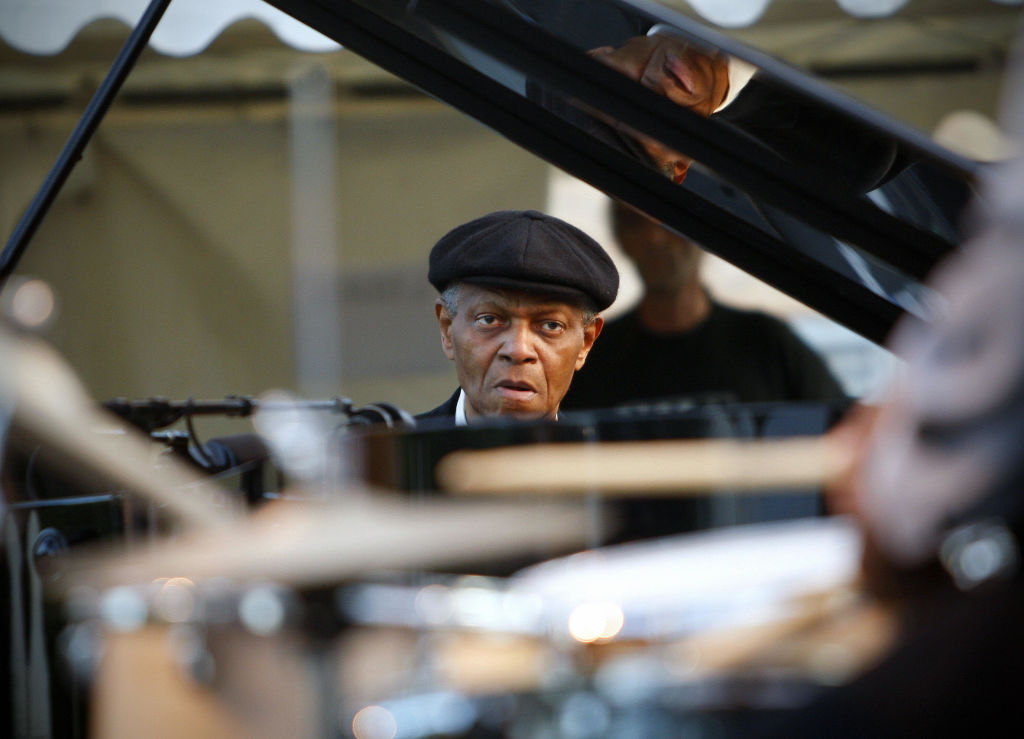‘My current pianist, McCoy Tyner, holds down the harmonies, and that allows me to forget them,’ John Coltrane said in an interview in 1961. ‘He’s sort of the one who gives me wings and lets me take off from the ground from time to time.’ Tyner, who died on Friday at the age of 82, will be remembered for his crucial role supporting John Coltrane during some of the legendary saxophonist’s most creative years. But on the occasion of Tyner’s death it’s also worth recognizing that ‘the Real McCoy’ had a penetrating voice and lasting influence all his own.
A son of west Philadelphia born in 1938, Tyner was encouraged by supportive parents and was playing piano by 13. In his jazz-rich hometown he was influenced by fellow Philadelphian Bud Powell, the pioneer of bebop piano, and he soon befriended Coltrane, 12 years his elder, who was living nearby with his mother between stints in Miles Davis’s quintet. In 1956 the two set plans to team up in the future, once Coltrane had started his own group and once Tyner had the chops to keep up. Four years later the moment came when Trane, halfway through a long engagement with his own group at New York’s Jazz Gallery, came calling for McCoy.
It was an important transitional moment in the saxophonist’s career. Coltrane had recently recorded his landmark album Giant Steps, in which his distinctive ‘sheets of sound’ style of soloing achieved its highest level of expression — blindingly fast arpeggios and scales that catapulted themselves over rapid-fire chordal progressions to the highest and lowest registers of his instrument. But his introduction to modal jazz through Miles Davis’s Kind of Blue, combined with a burgeoning interest in both experimental free jazz and Indian ragas, led Coltrane to simplify his songs’ chordal form. These newly uncluttered harmonic structures — often staying on a single chord for dozens of bars — inspired impassioned, eastern-sounding improvisations that punched hard against the outer limits of melodic reason.
Setting into these uncharted territories, Coltrane turned to a mostly untested 21-year-old Tyner, then tapped the polyrhythmic ear of drummer Elvin Jones and eventually brought on bassist Jimmy Garrison. The four comprised what became known as Coltrane’s ‘classic Quartet’, and their collective achievement over the next five years would place them among the greatest jazz ensembles of all time.
Incredibly, the impossibly young McCoy kept pace with his bandmates. He proved capable of providing not only a steadying presence to Trane’s increasingly untethered improvisations, but also leading the group into new harmonic and melodic ideas through his individual style of comping and soloing. In late 1960, Tyner first entered the studio with Coltrane, producing a series of recordings that ultimately became the 1961 album My Favorite Things, a surprise hit for Atlantic Records. Tyner’s solo on the title track, relying heavily on block chords based in fourths and fifths — intervals with roots in Gregorian chant — is an incandescent demonstration of the pianist’s sound, incantatory, percussive and instantly recognizable.
Tyner was crucial to the success of Coltrane’s quartet. Subsequent master performances include Live! At the Village Vanguard, Live at Birdland, and A Love Supreme, regarded by many as Coltrane’s greatest single work. But when the saxophonist began adding personnel to his group, causing the music to become ever-more dissonant, Tyner began to feel the harmonic squeeze. ‘I didn’t see myself making any contribution to that music,’ he’d later say. ‘All I could hear was a lot of noise. I didn’t have any feeling for the music, and when I don’t have feelings, I don’t play.’ In 1965, he left the group and embarked on an independent career.
With the funk and rock crazes of the 1960s in full force, it wasn’t an auspicious moment to set out solo in jazz. Though Tyner’s work with Coltrane made him one of the most sought-after studio accompanists of the art form, the years immediately following his departure from Coltrane were so financially lean that he considered driving a cab to support himself and his family. Nevertheless, Tyner held true to his voice and vision. Many serious musicians in the period experimented with the emptier forms and electrified sounds of popular music — to mostly disastrous effects — but Tyner never seems to have seriously considered following suit: ‘I’m in love with my instrument, so I basically stayed away from fusion. I wasn’t drawn to it at all. My sound and self are definitely embodied in the acoustic piano.’
Tyner’s confidence in his artistic purpose speaks not only to his integrity, but also to the central role that the piano played in making it come alive. The piano, an orchestra unto itself, is perhaps the most intellectually expansive of instruments, but Tyner added an uncommon sense of corporeal, visceral touch to his wicked smart playing — something a keyboard or synthesizer could never replace. Watch Tyner’s hands as he solos on Mongo Santa Maria’s ‘Afro Blue’, in a 1963 Coltrane Quartet performance for Ralph Gleason’s Jazz Casual public television program. Has there ever been a pianist who brought such dagger-like intensity, such contained energy, to tickling the ivories?
By the early Seventies, Tyner’s recognition caught up to his influence, and he was subsequently enshrined among the noblest of jazz royalty. He continued to record and to perform his music around the world until relatively recently. With his death, we’ve lost our last living link to perhaps the greatest jazz quartet ever, but more importantly, we’re stripped of an individual and searching voice. Give him a careful listen: as Coltrane said of his friend and bandmate, ‘He can take anything, no matter how weird, and make it sound beautiful.’



















